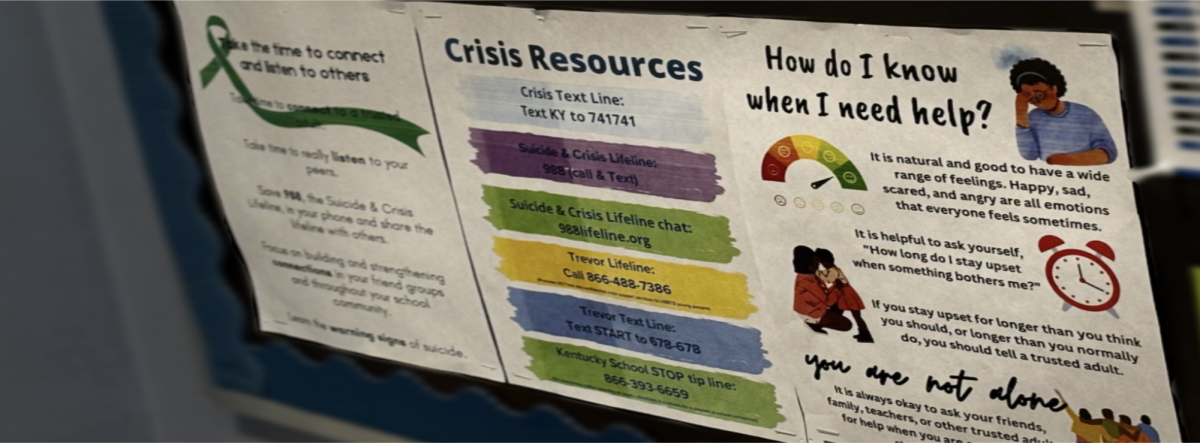Suicide is the second leading cause of death in teens worldwide. According to the Jed Foundation, 12.5 million people between the ages of 18 and 25 experienced a mental, behavioral, or emotional health issue in the past year.
This issue continues to rage on despite numerous ways to prevent suicide and the growing availability of resources for those struggling. The Highlands community is working to help students with mental health and prevent suicide one step at a time.
Many teens struggle with mental health and thoughts of suicide, and many suffer in silence. There are a lot of posters and ways to get help around the school, for everyone to view. Teachers are educating students and teens to help themselves and their peers.
“The message I’d give to my students is: you don’t want to do a permanent action for a temporary problem,” health teacher Kyle Finfrock said.
Finfrock has a classroom environment that helps students feel welcome and able to talk about anything. Giving students reassurance about their place and telling them that they belong can greatly impact their decisions. It’s important for students to know teachers they can talk to for advice and help.
“Everything gets better, and I truly believe that, especially here in high school, you have the rest of your life ahead of you, and you do not want to end that early because of a split-second decision,” Finfrock said.
It can be hard for even teachers to know how to guide students in the right direction, because every student acts differently when coping with their mental health. The counselors always try their best to help each student, depending on their situation.
“Being able to get to the student and help them and knowing that they hear what we have to say as counselors to them, to help that mindset change, to where they are with their thoughts versus getting away from their thoughts,” counselor Ann Listerman said.
Listerman’s perspective highlights how counselors work to make sure students feel heard and seen. The counselors also help educate not only the students but also the teachers.
However, support doesn’t only come from staff. Sometimes, it’s the small check-ins from peers that make the biggest difference for students struggling. Identifying ways to help out others or check in on them is important. Asking what they think would be helpful in a situation can also benefit students not having to come out for themselves.
“Just, like, a simple, ‘Are you okay?’ Or, like… just asking them what’s wrong. Yeah, like… I guess, like, any sort of, like, communication with them. To make sure, just, like, to check in,” Josie Messmer (9) said.
Telling an adult or parent if a loved one or peer at school is struggling is important. Counselors’ doors are open for students struggling with mental health.
“Really, I would say if you have a connection with the parents, definitely hit parents first. But if it’s something here at school, like, definitely either a teacher, counsellor, you know, administrator, an adult, that you trust, one that you know will take care of the situation,” Listerman said.
There are a lot of signs one may be considering suicide, but knowing the most common signs can potentially help save someone from taking their own life. According to Health Beat, the most common signs include “Changes in eating and sleeping behaviors, withdrawal from friends and family members, neglect of personal appearance, lack of response to praise.” These signs can show up in peers or friends, so it is best to be observant.
“If they, like, don’t talk as much, they don’t share, like, after life a lot. They sleep a lot…they’re, like, isolated. They don’t eat,” Messmer described when asked about signs of potential suicide.
Messmer brings up multiple ways someone could be struggling with mental health. She mentions isolation, eating disorders, and mental fatigue or tiredness.
Not all people show signs when hurting. Discussing suicide gives teens a safe space to share their feelings. Making sure people are aware that suicide happens is a big goal for the counseling department.
“Educate, educate, educate. I think there’s this myth out there that if you don’t talk about it, it won’t happen. Or if you don’t talk about it, it’s fine. But if you talk about it, you’re giving ideas,” Listerman said.
A lot of people think that not talking about it will keep kids safe, but in reality, it just means they don’t know what to do. Talking about things openly actually helps prevent problems instead of causing them.



